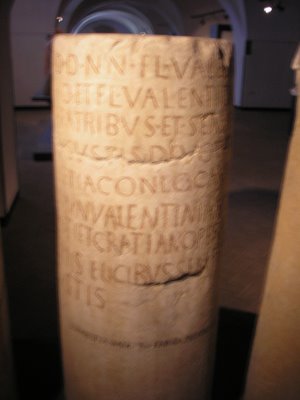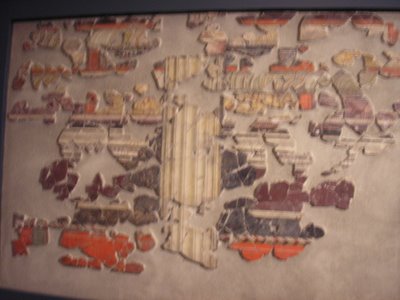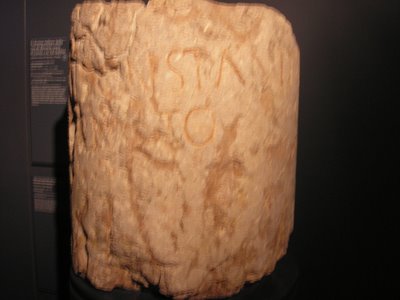Thursday, May 04, 2006
Wednesday, May 03, 2006
Brescia/Santa Giulia Museo della Citta' (1)
This past weekend I visited the Museo della Citta' in Brescia (Northern Italy), and am convinced that it is one of Italy's best-kept secrets. The museum, housed in a former monastery and a couple of church buildings and located on a street that follows the path of the ancient Decumanus Maximus of the Roman city Brixia, is enormous. It has two itineraries: one which takes you through the history of the town and its surroundings from the prehistoric period all the way through the Venetian period. The other itinerary takes you through the history of the monastery. This post and the next (at least) will focus on some highlights of the first itinerary, and I'll try to do another post on the second. For interested parties, here are some links for the museum: one, two, three.
(Some of these photographs will be blurry, since parts of the museum were a little dark and the use of a flash is not allowed.)
The exhibit on the Roman period had several milestones from the area from the late antique period (Constantine, Valens, Valentinian, etc.). Here is one example:
They also had fragments of fresco from a Republican temple on display. I especially like the second with it's imitation of different types of marble veneer:

That's all I have time for at the moment, but I'll try to continue the series soon.
Posted by
Eric
at
5/03/2006 06:35:00 AM
![]()
Archaeologists discover unusual network of burial chambers in Rome
This is the first I've heard about this...
By John Thavis
Catholic News Service
ROME (CNS) -- Archaeologists repairing a Roman catacomb have discovered an unusual network of underground burial chambers containing the elegantly dressed corpses of more than 1,000 people, a Rome official said.
The rooms appear to date back to the second century and are thought to be a place of early Christian burial. Because of the large number of bodies deposited over a relatively short period, experts believe a natural disaster or epidemic may have occurred at the time.
The corpses, dressed in fine clothes embroidered with gold thread, were carefully wrapped in sheets and covered in lime. Balsamic fragrances were also applied, according to Raffaella Giuliani, chief inspector of the Roman catacombs, who spoke with Vatican Radio May 1.
The discovery will be officially presented in June by the Pontifical Roman Academy of Archaeology, which excavated the site in collaboration with Rome's Ecole Francaise and the University of Bordeaux in France.
Giuliani said the burial chambers were found accidentally in 2003, when experts were repairing a cave-in located in the Catacomb of Sts. Peter and Marcellinus, one of Rome's lesser-known catacombs that is closed to the public.
The archaeologists discovered a large room behind one of the painted walls of the catacombs, then a series of similar rooms.
"These were not galleries or cubicles, but big rooms completely full of skeletons. We had to work very carefully to excavate them without destroying them," Giuliani said.
"We were amazed at the high number of individual corpses found in these rooms," she said. The rooms appear to predate the catacombs, which were built in the third century.
Giuliani said the experts believe they were Christian burial places, in part because Christians of that time dedicated great care to burial. Early Christians buried rich and poor with great dignity, in expectation of the resurrection of the dead -- a fact that helps explain the presence in Rome of more than 50 miles of underground catacombs.
UPDATE: Well, I see that the Rogueclassicist beat me to this one, but I'll leave it up in case anyone missed it!
Posted by
Eric
at
5/03/2006 06:14:00 AM
![]()





